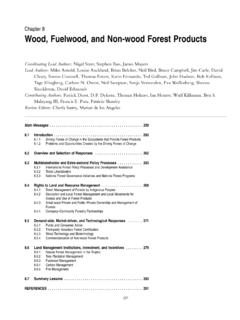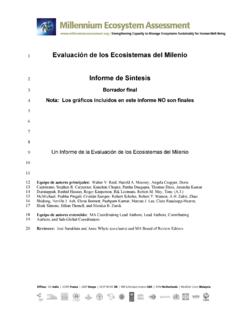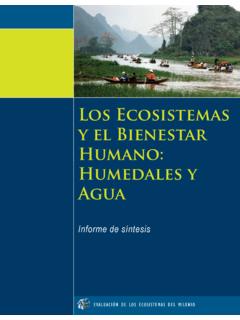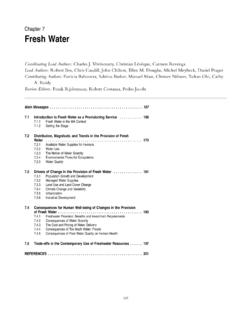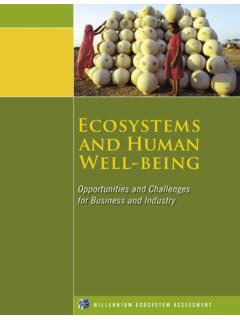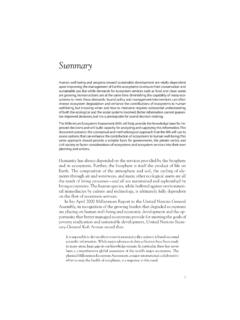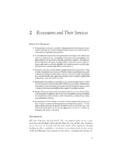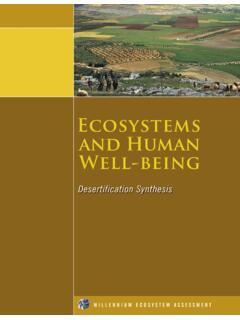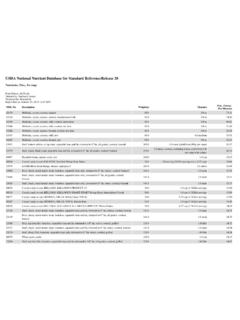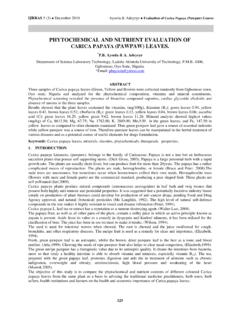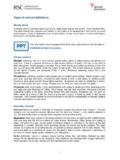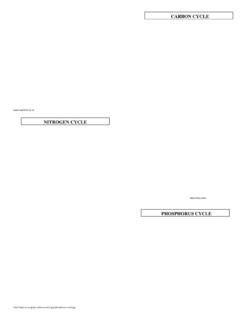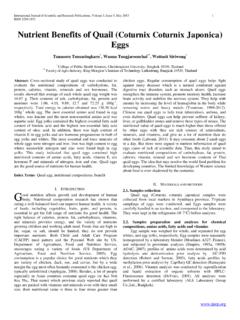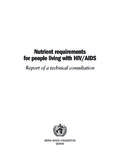Transcription of Chapter 12 Nutrient Cycling - Millennium Assessment
1 Chapter 12. Nutrient Cycling Coordinating Lead Authors: Patrick Lavelle, Richard Dugdale, Robert Scholes Lead Authors: Asmeret Asefaw Berhe, Edward Carpenter, Lou Codispoti, Anne-Marie Izac, Jacques Lemoalle, Flavio Luizao, Mary Scholes, Paul Tre guer, Bess Ward Review Editors: Jorge Etchevers, Holm Tiessen Main Messages .. 333. Introduction .. 333. Important Issues Common to All Nutrient Cycles .. 335. Ecosystem Stoichiometry: The Balance between Nutrients The Role of Organic Matter Nutrient Retention in Ecosystems: Buffers and Safety Nets at All Scales Soil Erosion Input and Output Processes Global Nutrient Cycles .. 340. The Global Nitrogen Cycle The Global Phosphorus Cycle The Global Sulfur Cycle The Global Carbon Cycle Consequences of Changes to Nutrient Cycles .. 344. Nutrient Excess in Fresh and Marine Waters Nutrient Deficiencies Threats to the Global Marine Nutrient Cycling System Monitoring and Assessment .. 347. Implications of Altered Nutrient Cycles for Human Well-being.
2 347. REFERENCES .. 351. 331. 332 Ecosystems and Human Well-being: Current State and Trends BOXES Global Map of Soil Sensitivity to Acidic Inputs from Iron as an Essential Fertilizer in Oceans Atmospheric Sulfur and Nitrogen Deposition*. Silicon: A Key Element Linking Land to Ocean Ecosystems TABLES. Case Study of Eutrophication of Inland Waters: Lake Victoria, Major Elements Needed for Plant Growth and Their East Africa Concentrations in Plants, the Upper Meter of Soil, and Ocean FIGURES Water Global Dust Deposition Total Nutrient Balance in Africa Key Pools, Fluxes, and Turnover Times in the Global Total Nutrient Balance in Latin America and in Central Nitrogen Cycle as Modified by Human Activity America and the Caribbean Contrast between Contemporary and Preindustrial Loadings Stocks of Carbon in Major Compartments of the Earth of Easily Transported Nitrogen onto Land Mass of Earth and System and Their Residence Times Geography of Relative Increases in Riverborne Nitrogen Problems in Ecosystem Functioning Linked to Nutrient Fluxes Resulting from Anthropogenic Acceleration of Cycle* Cycling Dysfunctions and Indicators to Assist Diagnostic Schematic Diagram of Main Parts of Global Phosphorus Biophysical Structures That Allow Regulation of Nutrient Cycle Cycling at Different Scales, Processes Involved.
3 And Main Pools and Fluxes in Global Sulfur Cycle Indicators of Their Functionality *This appears in Appendix A at the end of this volume. Nutrient Cycling 333. Main Messages This Chapter deals mainly with nitrogen, sulfur, phosphorus, and carbon all elements needed in relatively large quantities (the so- An adequate and balanced supply of elements necessary for life, pro- called macronutrients), and with cycles that have been substan- vided through the ecological processes of Nutrient Cycling , underpins all tially altered by human activities. Emerging issues related to iron other ecosystem services. The cycles of several key elements phosphorus, and silicon will also be addressed. Broadly speaking, nutrients can occur in gaseous form (such nitrogen, sulfur, carbon, and possibly iron and silicon have been substantially as N2, CO2), mineral form (such as apatite, the main P-containing altered by human activities over the past two centuries, with important positive mineral), inorganic ionic form (NH4 , NO3 , SO42 , H2PO4 ), and negative consequences for a range of other ecosystem services and for and organic form (bound into various C-based compounds in liv- human well-being.)
4 Ing or dead organisms or their products). Nutrients are mostly taken up by plants in the ionic form and by animals in organic In preindustrial times, the annual flux of nitrogen from the atmosphere to the forms through consumption of living or dead tissues; microorgan- land and aquatic ecosystems was 90 130 teragrams (million tons) per year. isms in general may use nutrients in any mineral or organic form, This was more or less balanced by a reverse denitrification'' flux. Production with sometimes high degrees of specialization at the guild or spe- and use of synthetic nitrogen fertilizer, expanded planting of nitrogen- cies level. The interconversion between forms is mediated by the fixing crops, and the deposition of nitrogen-containing air pollutants ecosystem. have together created an additional flux of about 200 teragrams a year, Nutrient Cycling describes the movement within and between only part of which is denitrified. The resultant N accumulation on land and the various biotic or abiotic entities in which nutrients occur in the in waters has permitted a large increase in food production, but at the cost global environment.
5 These elements can be extracted from their mineral or atmospheric sources or recycled from their organic of increased emissions of greenhouse gases and a frequent deterioration in forms by converting them to the ionic form, enabling uptake to freshwater and coastal ecosystem services, including water quality, fisheries, occur and ultimately returning them to the atmosphere or soil. and amenity value. Nutrient Cycling is enabled by a great diversity of organisms and leads to creation of a number of physical structures and mecha- Phosphorus is also accumulating in ecosystems at a rate of nisms that regulate the fluxes of nutrients among compartments. teragrams per year, which compares with the preindustrial rate of 1 6 These structures and processes act as buffers to limit losses and teragrams of phosphorus a year, mainly as a result of the use of mined transfers to other ecosystems, as described later. Nutrients are dis- P in agriculture. Most of this accumulation is occurring in soils, which may tributed among a large number of living or dead compartments, then be eroded into freshwater systems, causing deterioration of ecosystem and their relative abundance among these compartments is typical services.
6 This tendency is likely to spread and worsen over the next decades, of certain ecosystems. For example, this is the case in terrestrial since large amounts of P have accumulated on land and their transport to ecosystems, where nutrients may be greatly concentrated in living water systems is slow and difficult to prevent. biomass (such as tropical rainforests) or in humus and soil organic matter (such as tundra ecosystems) (Lavelle and Spain 2001). Fertility is the potential of the soil, sediment, or water system Sulfur emissions have been progressively reduced in Europe and North to supply Nutrient elements in the quantity, form, and proportion America but not yet in the emerging industrial areas of the world: China, required to support optimum plant growth (implicitly, in the con- India, South Africa, and the southern parts of South America. A global text of ecosystem services, for human benefit). The largest flux Assessment of acid deposition threats suggests that tropical ecosystems are of nutrients is their release from organic materials, as a result of at high risk.
7 Human-induced alteration of the iron and silicon cycles is less well decomposition by microbial communities. This flux may not be understood, but it is believed, with medium certainty, to be a significant factor measurable, as part of it may be immediately reincorporated in in altering the productivity of the ocean. This may be a significant benefit to microbial biomass. Microbial activity depends primarily on the the service of carbon sequestration. availability of a food source and on regional and local climatic, edaphic, or hydrological factors. Locally, biological parameters Human actions, many associated with agriculture, have increased the such as the chemical composition of the organic material (which leakiness'' of ecosystems with respect to nutrients. Tillage often dam- depends in turn on the plant community that produced it) and ages soil structure, and pesticides may decrease useful nontarget organisms, the soil invertebrates present act as proximate determinants.
8 The maintenance of fertility is a supporting service for the increasing Nutrient leaching. Simplification of the landscape and destruction of production of food, timber, fiber, and fuel. It is also necessary for riparian forests, wetlands, and estuaries allow unbuffered flows of nutrients ecological processes such as succession and for the persistence and between terrestrial and aquatic ecosystems. Specific forms of biodiversity are stability of ecosystems. In systems intensively managed by hu- critical to the performance of the buffering mechanisms that ensure the efficient mans, such as cultivated systems, the inherent fertility of ecosys- use and Cycling of nutrients in ecosystems. tems is supplemented through fertilization and management practices, such as the use of N-fixing plants, the acceleration of In contrast to the issues associated with Nutrient oversupply, there re- microbial processes by tillage, the addition of suitable organic in- main large parts of Earth, notably in Africa and Latin America, where puts to the soil, and, in many parts of the world, biomass burning.
9 Harvesting without Nutrient replacement has led to a depletion of soil Fertilization is the input of nutrients to a system by humans, fertility, with serious consequences for human nutrition and the environ- deliberately or as an unintended consequence of other activities. ment. It includes supplements of N, P, S, potassium, calcium, magne- sium, and micronutrients for agriculture; atmospheric N and S. deposition; and the effects of elevated CO2 in the atmosphere. Introduction Iron fertilization in the ocean has been performed experimentally (Coale et al. 1996; Moore et al. 2001). Nutrients comprise the 22 or so chemical elements known to be It is possible to have an excessive supply of nutrients. In essential for the growth of living organisms. (See Table ) aquatic systems, this condition is known as eutrophication. Eutro- The list varies somewhat because some elements are only needed phication, usually resulting from leaching of nutrients from soils in very specific groups of organisms or specific circumstances.
10 Managed for agriculture, is a form of nonvoluntary fertilization of 334 Ecosystems and Human Well-being: Current State and Trends Table Major Elements Needed for Plant Growth and Their Concentrations in Plants, the Upper Meter of Soil, and Ocean Water (Fortescue 1980; Bohn et al. 1979). Content in Elemental Form ( g/g ). Element Plant Soil Ocean Major Forms Biological Function/Source Macronutrients (> % of dry mass). C 454,000 20,000 28 CO2 in organic molecules; ; OM. O 410,000 490,000 857,000 O2 in organic molecules; cellular respiration/water; OM. H 55,000 650 108,000 H 2O in organic molecules/water; OM. N 30,000 1,000 NO3 or NH4+ in proteins, nucleic acids, and chlorophyll/biol. fix of N2;. OM mineralization; atm. deposition K 14,000 10,000 380 K+ principal positive ion inside cells; control of stomatal aperture;. enzyme activity/OM mineralization; weathering P 2,300 800 H2PO4 or HPO42 in nucleic acids, phospholipids, and electron carriers in chloroplasts and mitochondria/OM mineralization; weathering Ca 18,000 10,000 400 Ca2+ in adhesive compounds in cell walls; control of membrane permeability; enzyme activation/weathering; OM mineralization Mg 3,200 6,000 1,350 Mg2+ component of chlorophyll; enzyme activation; ribosome stability/weathering; OM mineralization S 3,400 500 885 SO42 component of proteins and many coenzymes/OM mineralization.
